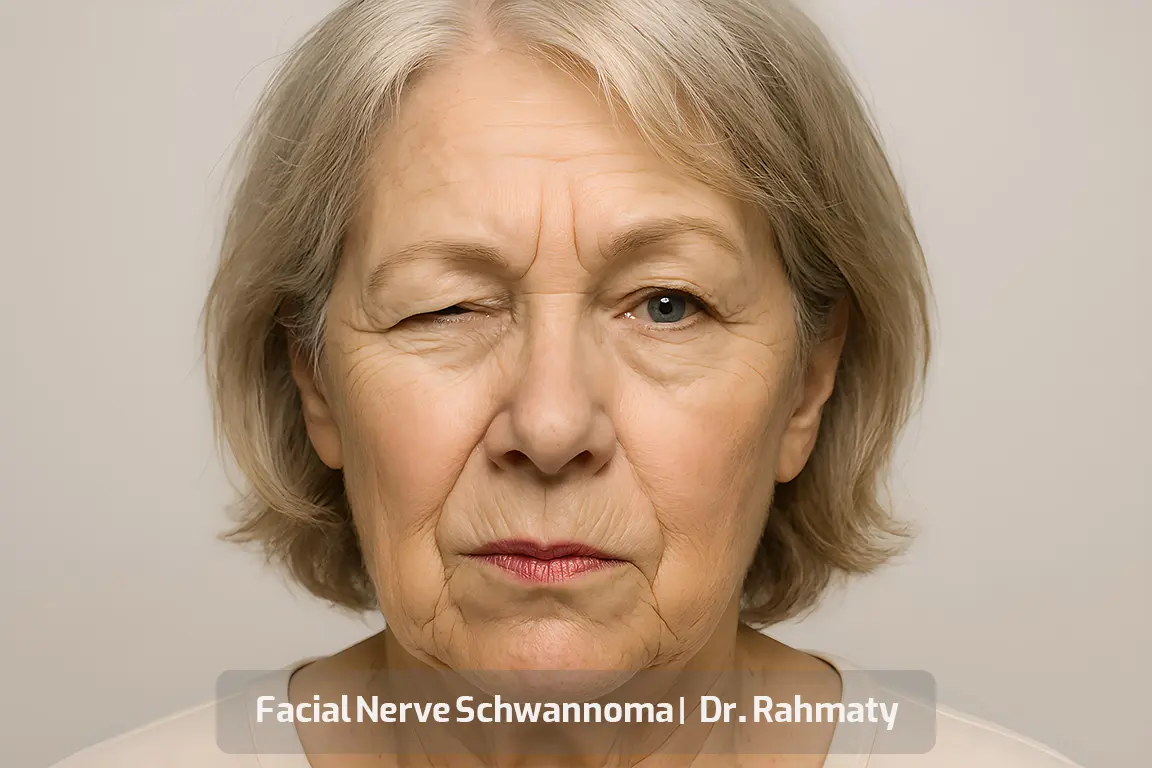A Rare Case Report: Bilateral Hemifacial Spasm Caused by Bilateral Facial Nerve Schwannoma
To present a case of bilateral hemifacial spasm (BHFS) and bilateral facial nerve schwannoma (FNS), and to explain the differential diagnosis, clinical manifestations, genetic associations, and CT and MRI features of facial nerve schwannoma.
Background
Hemifacial spasm (HFS) is a hyperactive cranial neuropathy that causes paroxysmal facial muscle contractions. Bilateral hemifacial spasm (BHFS) is a very rare neurological syndrome, diagnosed mainly by excluding other facial dyskinesias. Facial nerve schwannoma (FNS) can affect any part of the facial nerve (FN) and bilateral FNS-induced BHFS is extremely rare.
Case Presentation
A 39-year-old woman presented with bilateral HFS and bilateral FNS. She showed grade II facial nerve dysfunction according to the House-Brackmann scale on the right side. Continuous facial tics were observed on both sides, especially around the left eye. She received bilateral injections of botulinum toxin A and was enrolled in a scheduled follow-up program. Her symptoms improved at 1, 3, 6, and 12-month follow-ups. After one year, a follow-up MRI showed no change in lesion size compared to the initial MRI. The patient continued receiving bilateral botulinum toxin A injections every six months. We decided to monitor her with biannual injections and annual imaging.
Conclusion
Surgery is a good option for FNS removal but, in some cases where there is no significant facial paralysis or hearing loss, close monitoring and symptomatic treatment can be the best approach.
Background
Facial nerve schwannoma (FNS), also known as facial nerve neurinoma/neurilemmoma, originates from Schwann cells and can arise anywhere along the facial nerve path—from its origin at the cerebellopontine (CP) angle to its extracranial branches in the parotid space. Symptoms often result from mass effect on nearby structures, potentially causing sensorineural hearing loss, conductive hearing loss, middle ear mass, vestibular findings (oscillopsia, imbalance, postural instability), and facial nerve dysfunction such as idiopathic Bell’s palsy, weakness, focal contractions, and/or complete hemifacial spasm.
We report a case of bilateral FNS presenting with bilateral hemifacial spasm, including clinical, MR, and CT imaging findings.
Case Description
A 39-year-old woman presented to our tertiary otolaryngology clinic with bilateral involuntary facial twitching. Symptoms had progressively worsened over seven years, starting in the lower right face and later spreading to the upper regions, especially around the left eye. Contractions were mild but sudden and occurred about 30–40 times a day on the right and once weekly on the left.
The patient had a history of right facial palsy and had previously been treated with botulinum toxin without much improvement. She reported bilateral tinnitus and occasional headaches but no vision problems, blurred vision, hearing loss, or sensory complaints. Her past medical history included fatty liver and mild hyperlipidemia. She had been taking nortriptyline (10 mg/day), clonazepam (1 mg/day), escitalopram (10 mg/day), propranolol (10 mg/day), and buspirone (5 mg/day) for anxiety and depression for a year.
There was no family history of neurofibromatosis or other genetic disorders, although her son had undergone surgery and radiotherapy for cerebellar medulloblastoma.
Physical examination showed several freckle-like pigmented macules on her face, neck, and trunk, none exceeding 5 mm in diameter. A slight dysfunction of the facial nerve (House-Brackmann grade II) was seen on the right. Continuous facial tics were noted bilaterally, more around the left eye. Otoscopic examination was normal. Pure-tone audiometry was within normal limits.
CT and MRI revealed bilateral facial nerve schwannomas. Bilateral botulinum toxin A injections were administered according to Table 1. This intervention improved her spasms and headaches within two weeks.
She entered a structured follow-up program monitoring hearing, facial nerve function, signs, and symptoms. At 1, 3, 6, and 12 months follow-up, she showed symptomatic improvement and better facial nerve grading. After a year, MRI findings remained stable. Continued botulinum toxin injections were planned every six months, with yearly MRI imaging.
Most Involved Locations and Imaging Features
FNS most commonly involves the geniculate ganglion (83%), followed by the labyrinthine and tympanic segments (both 54%). Clinical presentation is typically facial neuropathy (42%). MRI features include lobulated enhancing masses with peripheral high signals (“target sign”) and cystic changes in larger lesions. Genetic testing for NF2 mutations was not performed in this case, although previous reports noted that about 2 out of 12 FNS cases were associated with neurofibromatosis.
Differential Diagnosis
Hemangiomas typically occur in the geniculate ganglion and present with rapid-onset sensorineural hearing loss (SNHL), imbalance or vertigo, mild facial weakness, and decreased corneal reflex. Early progressive facial weakness is characteristic of hemangiomas, and CT/MRI may show irregular bone margins and intratumoral bone spicules.
Congenital bilateral cholesteatoma is another rare differential, potentially compressing cranial nerves VII and VIII as it grows. Ischemia of the facial nerve can occur when cholesteatoma involves the geniculate ganglion, presenting more frequently with facial twitching and progressive facial paralysis than schwannomas.
Other differential diagnoses for facial spasms include peripheral nerve disorders such as cramps, neuromyotonia, tetanus, and psychogenic spasms. Primary hemifacial spasm (pHFS) may arise from neurovascular compression, psychogenic factors, tics, facial myokymia, or blepharospasm. Botulinum toxin A injections or microvascular decompression (MVD) can effectively suppress spasms, although Botox injections need to be repeated every 3–4 months.
Outcome
Despite a prior poor experience with botulinum toxin therapy, we opted for bilateral injections, similar to previous successful studies, and the patient responded well. We decided to continue biannual Botox injections and annual MRI surveillance.
Conclusion
Facial nerve schwannoma is a benign tumor, and its clinical presentation largely depends on its location. Facial spasms may be the only manifestation of the tumor. The geniculate ganglion is the most common origin site. Although surgical removal is an option, close monitoring and symptomatic management are preferable when hearing loss and facial dysfunction are not significant. Many patients are reluctant to risk facial paralysis, deafness, and surgical complications.




